Integrated Prediction Model for Upstream Reservoir Sedimentation in a Weir: A Comprehensive Analysis Using Numerical and Experimental Approaches
Abstract
1. Introduction
2. Theoretical Backgrounds
2.1. Reservoir Delta Theory
2.2. Model Description
- Flow velocity
- 2.
- Sediment load
- 3.
- Bed elevation change
3. Laboratory Experiments
3.1. Dimensional Analysis
3.2. Model Similarity
- -
- Estimate VS, ωds/ν, U*/ω from prototype and scaled model, respectively.
- -
- Calculate the particle Reynolds number (Re* = U*ds/ν) and Vc/ω in Equation (22).
- -
- Calculate Ct using Equation (21) and Qs using discharge.
3.3. Numerical Results of STAFF Model
3.4. Experimental Setup and Measuring Apparatus
3.5. Experimental Procedure and Condition
4. Results and Analysis
4.1. Experimental Results
4.2. Derivation of Empirical Equation
4.3. Error Analysis
5. Summary of Research
6. Conclusions and Future Direction
Author Contributions
Funding
Data Availability Statement
Conflicts of Interest
Nomenclature
| Symbols | Definitions |
| Ad | Sediment load amount per unit width |
| Ld | Stream-wise distance from the main body of the multi-purpose weir to the starting point of the reservoir delta in Figure 1 |
| VS | Unit stream power in Figure 2 |
| V and S | Flow velocty and river bed slope in Figure 2 |
| VS/ω | Non-dimensional unit stream power in Figure 2 |
| ω | Fall velocity in Figure 2 |
| U* | Friction velocity in Equation (1) |
| U*/ω | Ratio of the friction veocity in Equation (1) |
| R | Hydraulic radius in Equation (1) |
| g | Gravitational acceleration |
| τ* | Shields paramete in Equation (2) |
| τ0 | Bed shear stress in Equation (2) |
| γ | Specific weight of water in Equation (2) |
| G | Specific gravity of sediment, Equation (2) |
| ds | Sediment particle size in Equation (2) |
| h | Water surface elevation in Equation (3) |
| β | Energy coefficient in Equation (3) |
| hL | Energy loss in Equation (3) |
| Sf | Friction slope in Equation (4) |
| Δx | Stream-wise distance in Equation (4) |
| q | discharge per unit width in Equations (6) and (7) |
| Z | Bed elevation from datum in Figure 1 and Figure 2, Equations (7) and (9) |
| n | Manning’s roughness coefficient in Equations (8) and (9) |
| Cw | Sediment concentration by weight in Equations (11) and (12) |
| Cv | Sediment concentration by volume in Equation (12) |
| qs | Sediment discharge per unit width in Equation (13) |
| p | Porosity of soil in Equation (14) |
| t | Time in Equation (14) |
| x | Stream-wise length in Equation (15) |
| ΔZ | Bed elevation change in Equation (15) |
| Δt | Time step in Equation (15) |
| j and k | Spatial and temporal index in Equation (15) |
| ρ | Density of fluid in Equation (16) |
| ν | Kinematic viscosity in Equation (16) |
| D | Upstream normal depth in Equation (16) |
| Cu | Sediment non-uniformity constant in Equation (16) |
| Ct | Sediment concentration in parts per million by weight in Equation (22) |
| Vc | critical average flow velocity in incipient motion in Equation (22) |
| Zc | Dimensionless sediment deposition caculated using equation |
| Zm | Dimensionless sediment deposition measured by experiments |
| J | Number of experiments |
| Rj | Special discrepancy ratio |
References
- Morris, G.L.; Fan, J. Reservoir Sedimentation Handbook: Design and Management of Dams, Reservoirs, and Watersheds for Sustainable Use; McGraw-Hill: New York, NY, USA, 1998. [Google Scholar]
- Anton, J.S.; Mário, J.F.; Carmelo, J.; Giovanni, D.C. Reservoir sedimentation. J. Hydraul. Res. 2016, 54, 595–614. [Google Scholar] [CrossRef]
- Julien, P.Y. Erosion and Sedimentation; Cambridge University Press: New York, NY, USA, 1995. [Google Scholar] [CrossRef]
- White, R. Evacuation of Sediments from Reservoirs; Thomas Telford Publishing: London, UK, 2001. [Google Scholar] [CrossRef]
- Toniolo, H.; Parker, G. 1D numerical modeling of reservoir sedimentation. In Proceedings of the IAHR Symposium on River, Coastal and Estuarine Morphodynamics, Barcelona, Spain, 1–5 September 2003. [Google Scholar]
- Wright, L.D.; Coleman, J.M. Mississippi river mouth processes: Effluent dynamics and morphologic development. J. Geol. 1974, 82, 751–778. [Google Scholar] [CrossRef]
- Soni, J.P.; Ranga Raju, K.G.; Garde, R.J. Aggradation in streams due to overloading. J. Hydraul. Div. 1980, 106, 117–132. [Google Scholar] [CrossRef]
- Hotchkiss, R.H. Reservoir Sedimentation and Sluicing: Experimental and Numerical Analysis; St. Anthony Falls Hydraulic Laboratory: Minneapolis, MN, USA, 1990; Available online: https://hdl.handle.net/11299/108511 (accessed on 12 November 2023).
- Hotchkiss, R.H.; Parker, G. Shock fitting of aggradational profiles due to backwater. J. Hydraul. Eng. 1991, 117, 1129–1144. [Google Scholar] [CrossRef]
- Yang, C.T.; Simões, F.J.M. GSTARS Computer Models and Their Application, part I: Theoretical Development. Int. J. Sediment Res. 2008, 23, 197–211. [Google Scholar] [CrossRef]
- Simões, F.J.M.; Yang, C.T. GSTARS Computer Models and Their Applications, Part II: Applications. Int. J. Sediment Res. 2008, 23, 299–315. [Google Scholar] [CrossRef]
- Yang, C.T. Discussion of “Sediment Transport Modeling Review—Current and Future Developments” by A.N. Papanicolaou, M. Elhakeem, G. Krallis, S. Prakash, and J. Edinger. J. Hydraul. Eng. 2010, 136, 552–555. [Google Scholar] [CrossRef]
- Fan, J.; Morris, G.L. Reservoir sedimentation I: Delta and density current deposits. J. Hydraul. Eng. 1992, 118, 354–369. [Google Scholar] [CrossRef]
- Fan, J.; Morris, G.L. Reservoir sedimentation II: Reservoir desiltation and long-term storage capacity. J. Hydraul. Eng. 1992, 118, 370–384. [Google Scholar] [CrossRef]
- Ahn, J.; Yang, C.T.; Boyd, P.M.; Pridal, D.B.; Remus, J.I. Numerical modeling of sediment flushing, from Lewis and Clark Lake. Int. J. Sediment Res. 2013, 28, 182–193. [Google Scholar] [CrossRef]
- Choi, H. Experimental Investigation of Sedimentation at Multi-Purposed Weir. Master’s Thesis, Seoul National University, Seoul, Republic of Korea, 2014. Available online: https://s-space.snu.ac.kr/handle/10371/124243 (accessed on 12 November 2023). (In Korean).
- Kantoush, S.A.; Bollaert, E.; Schleiss, A.S. Experimental and numerical modelling of sedimentation in a rectangular shallow basin. Int. J. Sediment Res. 2008, 23, 212–232. [Google Scholar] [CrossRef]
- Gökçen, B.; Güney, M.S. Experimental investigation of sediment transport in steady flows. Sci. Res. Essays 2008, 5, 582–591. [Google Scholar]
- Dufresne, M.; Dewals, B.; Erpicum, S.; Archambeau, P.; Pirotton, M. Flow patterns and sediment deposition in rectangular shallow reservoirs. Water Environ. J. 2012, 26, 504–510. [Google Scholar] [CrossRef]
- Souza, L.B.S.; Schulz, H.E.; Villela, S.M.; Gulliver, J.S. Experimental study and numerical simulation of sediment transport in a shallow reservoir. J. Appl. Fluid Mech. 2010, 3, 9–21. [Google Scholar] [CrossRef]
- Bui, V.H.; Bui, M.D.; Rutschmann, P. Advanced Numerical Modeling of Sediment Transport in Gravel-Bed Rivers. Water 2019, 11, 550. [Google Scholar] [CrossRef]
- Latif, S.D.; Chong, K.L.; Ahmed, A.N.; Huang, Y.F.; Sherif, M.; El-Shafie, A. Sediment load prediction in Johor River: Deep learning versus machine learning models. Appl. Water Sci. 2023, 13, 79. [Google Scholar] [CrossRef]
- Legowo, S.; Hadihardaja, I.K.; Azmeri, A. Estimation of Bank Erosion Due to Reservoir Operation in Cascade (Case Study: Citarum Cascade Reservoir). J. Eng. Technol. Sci. 2013, 41, 148–166. [Google Scholar] [CrossRef]
- Yang, C.T. Unit stream power equations for total load. J. Hydrol. 1979, 40, 123–138. [Google Scholar] [CrossRef]
- Shields, A. Application of Similarity Principles and Turbulence Research to Bed-Load Movement; California Institute of Technology: Pasadena, CA, USA, 1936; (Translated from German). [Google Scholar]
- Brunner, G.W. HEC-RAS River Analysis System: Hydraulic Reference Manual, Version 5.0; US Army Corps of Engineers–Hydrologic Engineering Center, 547: Davis, CA, USA, 2016. Available online: https://www.hec.usace.army.mil/software/hec-ras/documentation/ (accessed on 2 December 2023).
- Lai, Y.G.; Gaeuman, D. SRH-2D User’s Manual: Sediment Transport and Mobile-Bed Modeling; US Bureau of Reclamation: Washington, DC, USA, 2009; Volume 179.
- Deltares. Delft3D-Flow. Simulation of Multi-Dimensional Hydrodynamic Flows and Transport Phenomena, Including Sediments: User manual; Deltares: Delft, The Netherlands, 2010. [Google Scholar]
- Engelund, F.; Hansen, E. A Monograph on Sediment Transport in Alluvial Streams; Tekniskforlag: Copenhagen, Denmark, 1967; Available online: http://resolver.tudelft.nl/uuid:81101b08-04b5-4082-9121-861949c336c9 (accessed on 2 December 2023).
- Lee, J.M.; Ahn, J. Analysis of Bed Sorting Methods for One Dimensional Sediment Transport Model. Sustainability 2023, 15, 2269. [Google Scholar] [CrossRef]
- Kim, S.K.; Kim, J.S.; Kim, K.H.; Choi, S.U. Prediction and Historical Analysis of Long-Term Bed Elevation Change in the Mankyung-Gang River. Ecol. Resilient Infrastruct. 2018, 5, 25–34. (In Korean) [Google Scholar] [CrossRef]
- Exner, F.M. Über die wechselwirkung zwischen wasser und geschiebe in flüssen. Sitzungsberichte Akad. Wiss. Math. Naturwissenschaftliche Kl. 1925, 134, 165–203. [Google Scholar]
- Dodaro, G.; Tafarojnoruz, A.; Sciortino, G.; Adduce, C.; Calomino, F.; Gaudio, R. Modified Einstein Sediment Transport Method to Simulate the Local Scour Evolution Downstream of a Rigid Bed. J. Hydraul. Eng. 2016, 142, 04016041. [Google Scholar] [CrossRef]
- Yang, C.T. Incipient Motion and Sediment Transport. J. Hydraul. Div. 1973, 99, 1679–1704. [Google Scholar] [CrossRef]
- Park, S.W.; Hwang, J.H.; Ahn, J. Physical Modeling of Spatial and Temporal Development of Local Scour at the Downstream of Bed Protection for Low Froude Number. Water 2019, 11, 1041. [Google Scholar] [CrossRef]
- Wang, L.; Cuthbertson, A.; Pender, G.; Zhong, D. Bed load sediment transport and morphological evolution in a degrading uniform sediment channel under unsteady flow hydrographs. Water Resour. Res. 2019, 55, 5431–5452. [Google Scholar] [CrossRef]




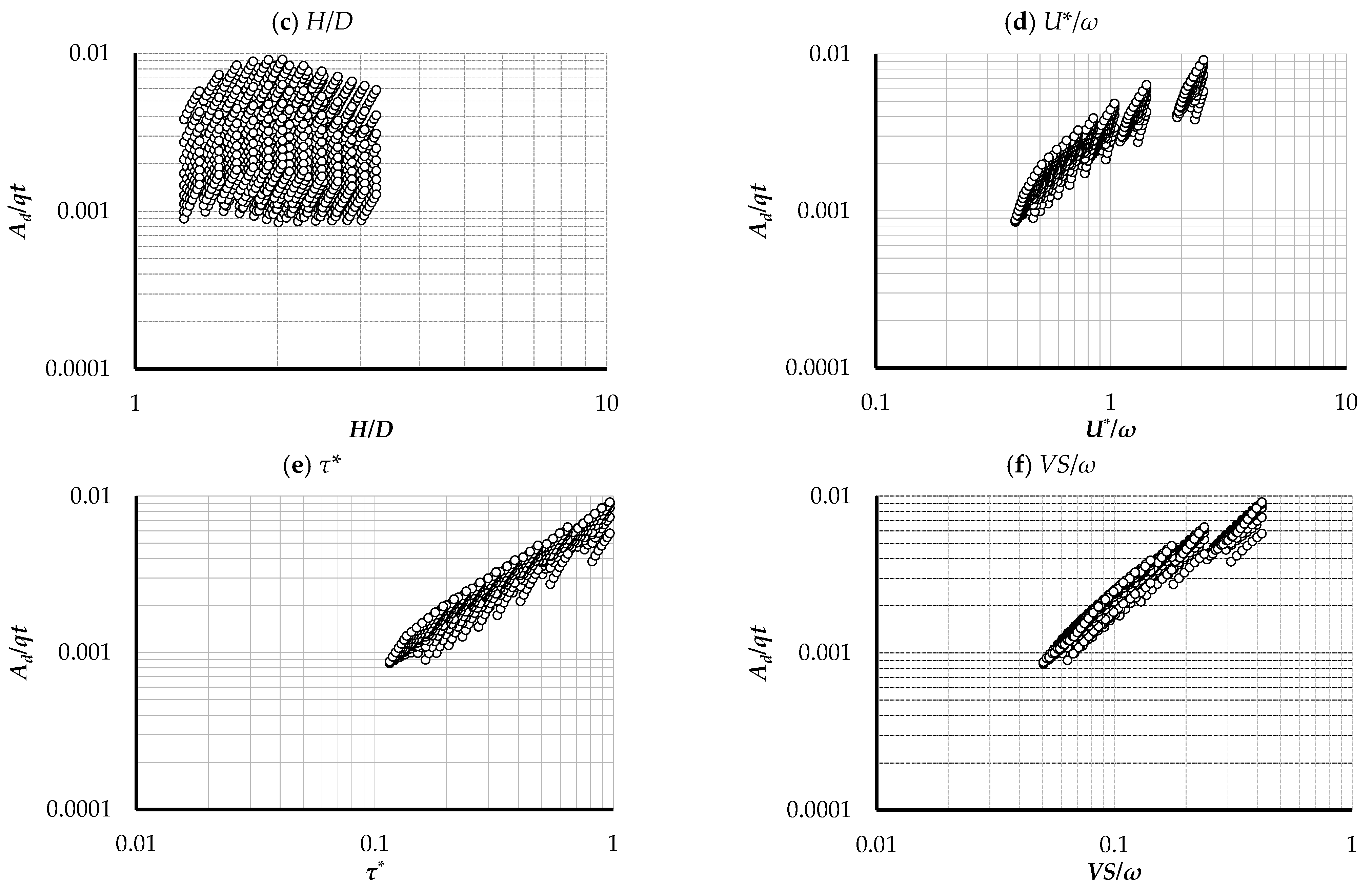
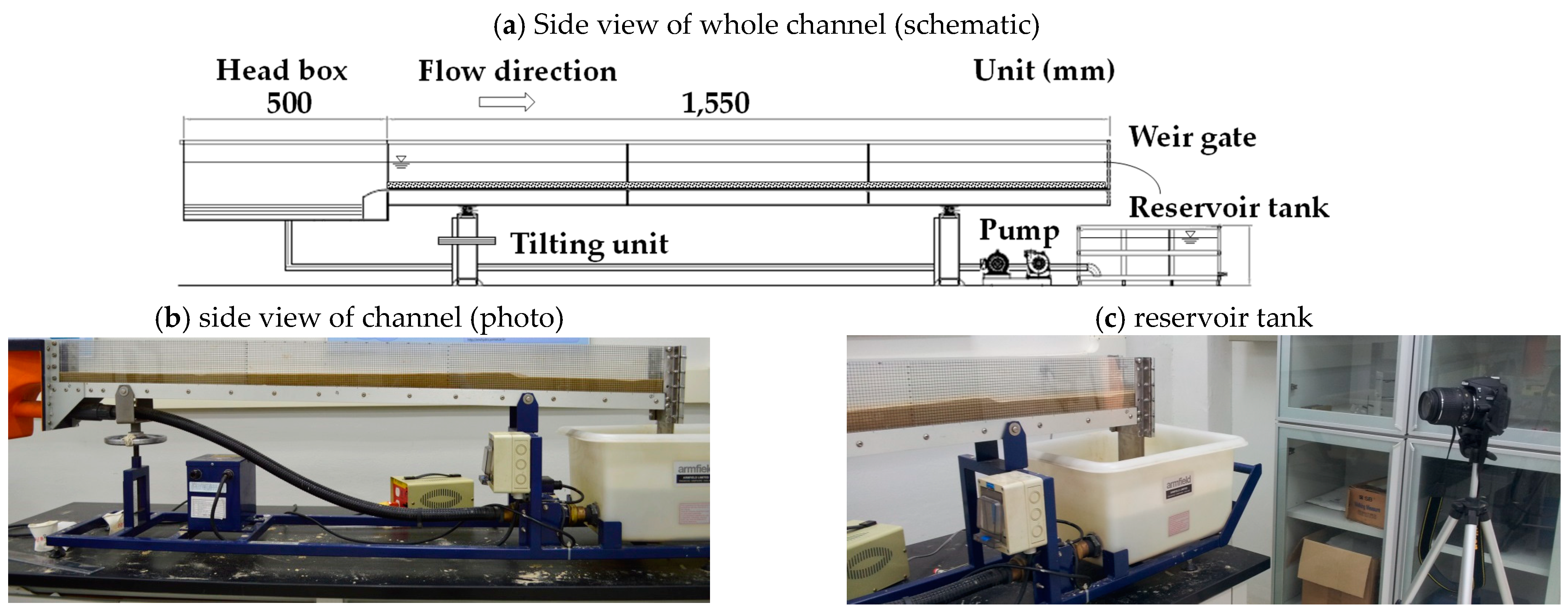

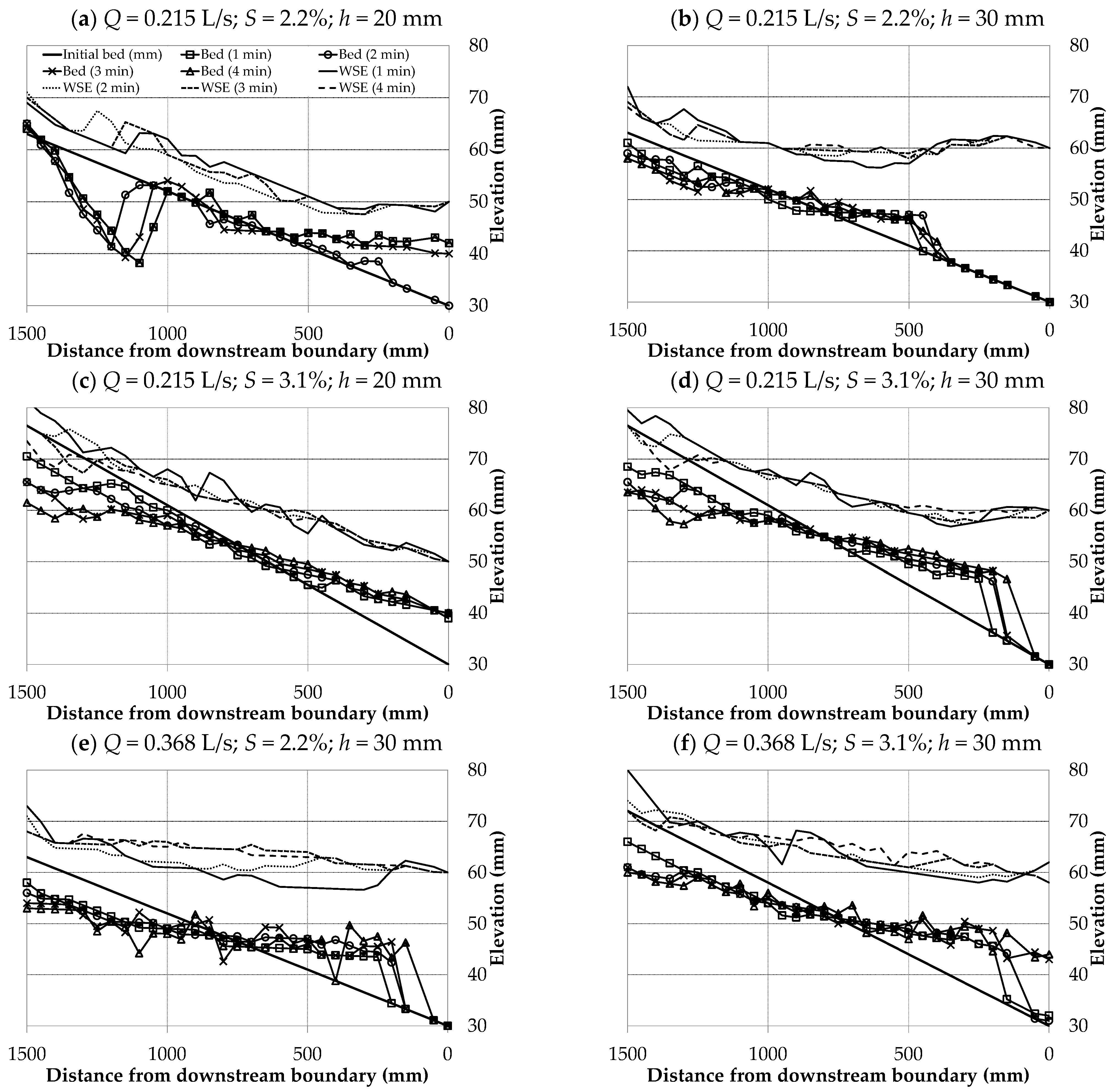



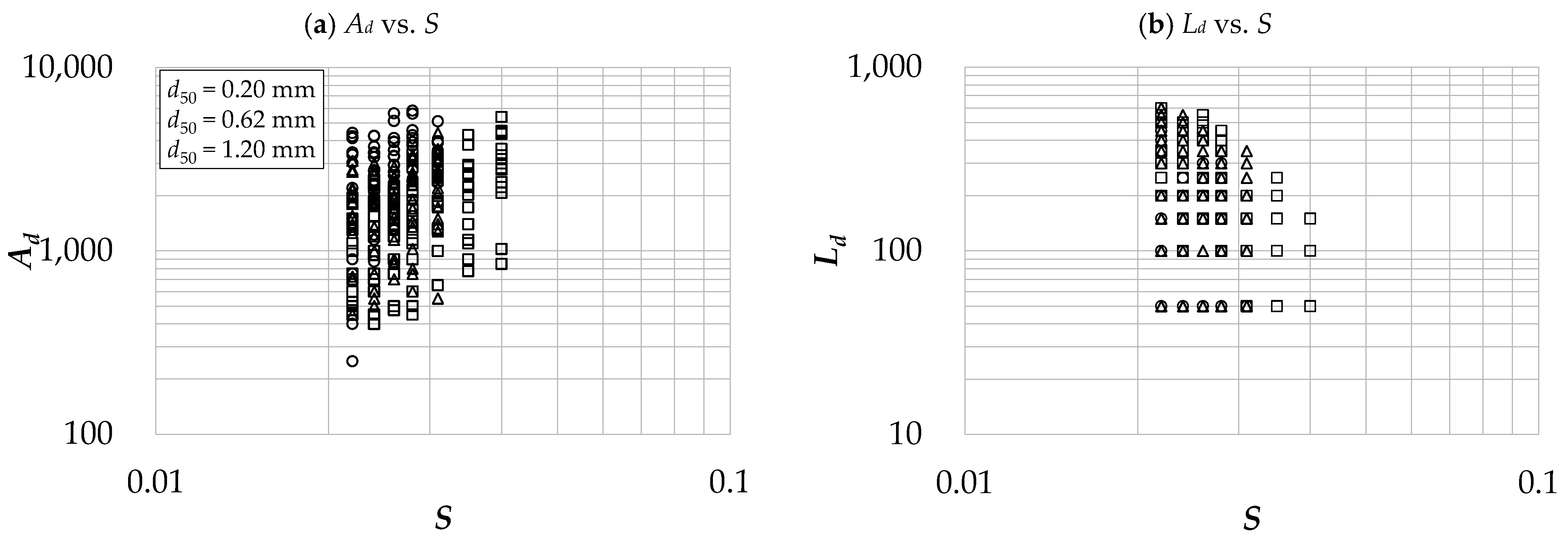
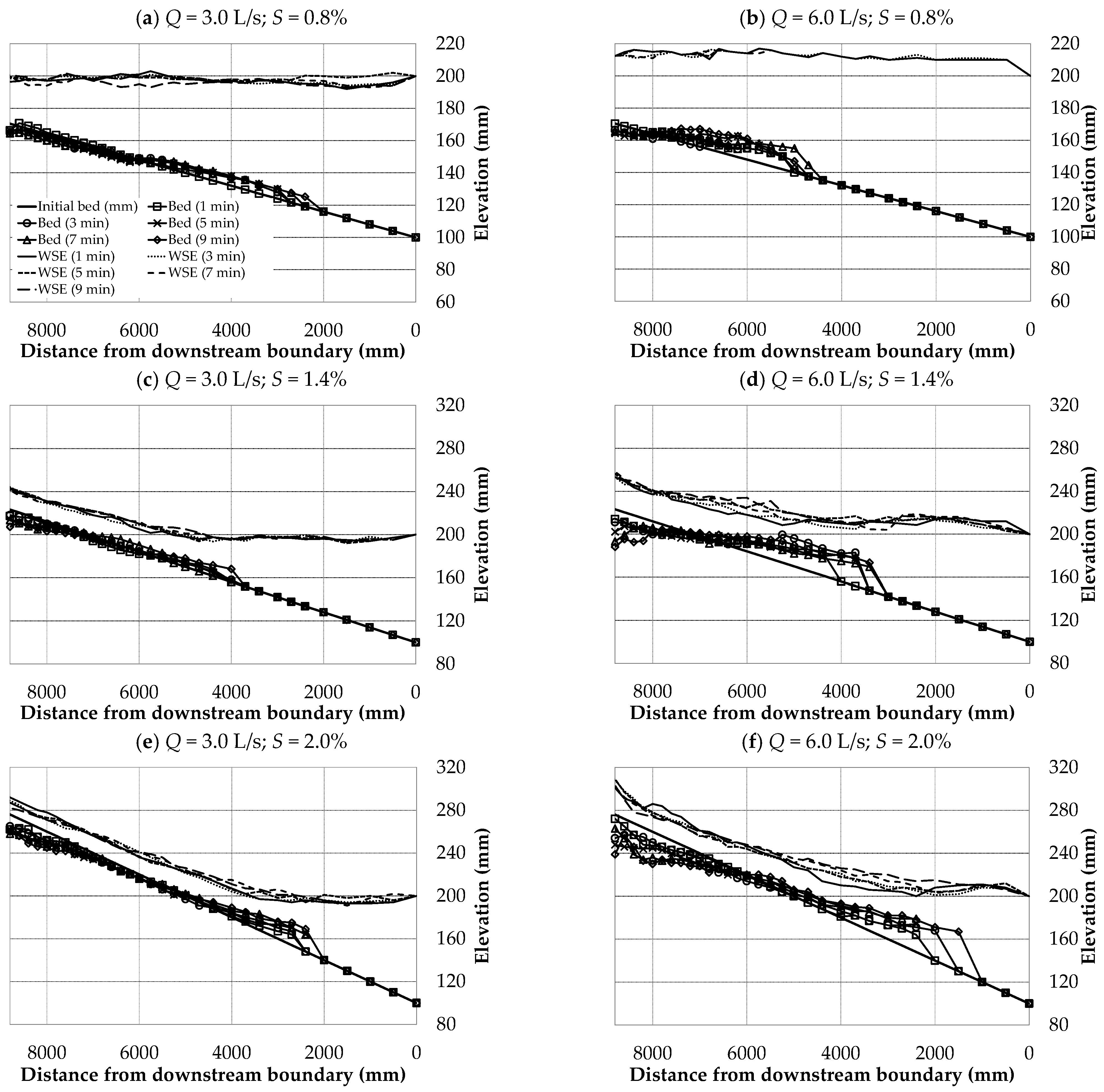


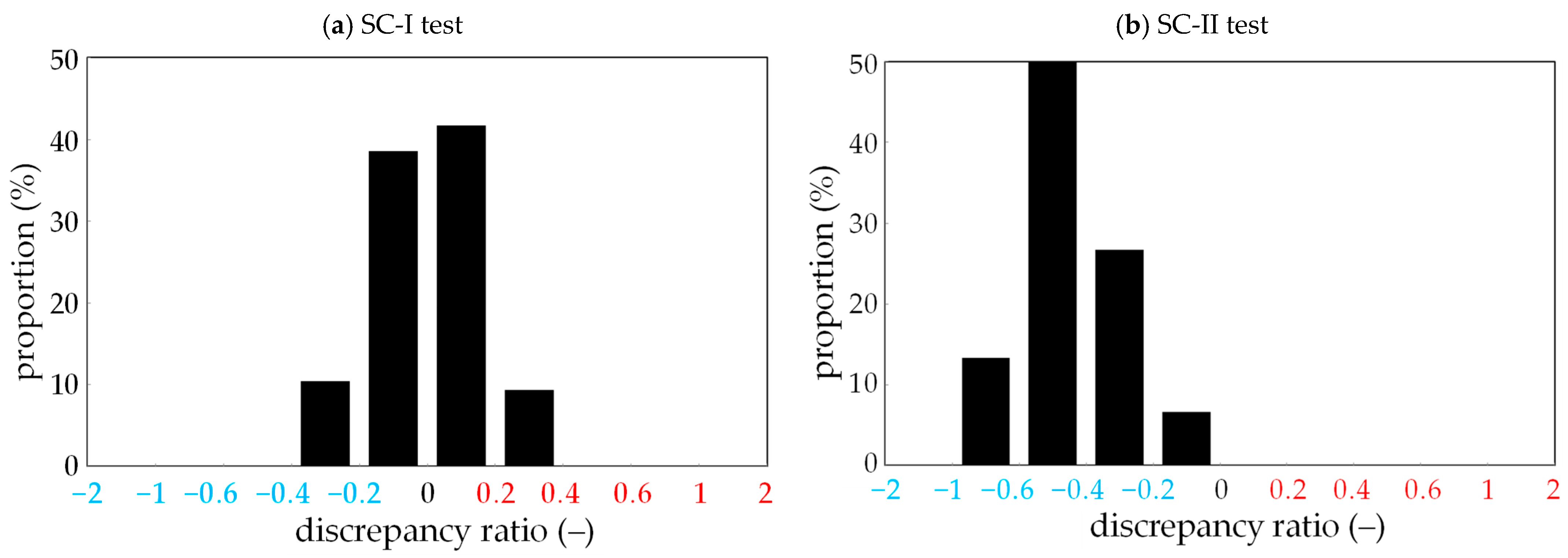
| Types | No. of Cases | S (%) | Q (L/s) | H (mm) | Re (=) | Fr (=) | d50 (mm) | D/d50 (−) | U*/ω (−) | τ* (Pa) | VS/ω (−) |
|---|---|---|---|---|---|---|---|---|---|---|---|
| SC-I tests | 288 | 2.2 −4.0 | 0.215 −0.368 | 20 −30 | 1049 −1773 | 0.061 −0.057 | 0.20 −1.20 | 2.5 −75.0 | 0.315 −2.46 | 0.0606 −1.188 | 0.0796 −0.650 |
| SC-II tests | 30 | 0.8 −2.0 | 3–6 | 100 | 9231 −18,462 | 0.050 −0.101 | 0.62 | 25.8 −45.2 | 0.488 −0.905 | 0.1251 −0.430 | 0.0021 −0.0188 |
| Parameter | D/ds | U*/ω | τ*/ω | VS/ω |
|---|---|---|---|---|
| Numerical Simulation | 0.8854 | 0.9042 | 0.9052 | 0.9451 |
| SC-I Experiments | 0.1081 | 0.2002 | 0.2110 | 0.3743 |
| Parameter | Derivation Data Set | Verification Data Set | ||||
|---|---|---|---|---|---|---|
| Range | Mean | Quartile | Range | Mean | Quartile | |
| Ad/qt | 0.0015–0.0142 | 0.0039 | 0.0025 | 0.0027–0.0085 | 0.0036 | 0.0028 |
| VS/ω | 0.0796–0.4024 | 0.2200 | 0.1307 | 0.1392–0.3356 | 0.2176 | 0.1720 |
| τ* | 0.6000–1.1879 | 0.1225 | 0.0888 | 0.1290–0.2346 | 0.1681 | 0.1350 |
| Experimental Case | Data Set | RMSE | MAE | AGD |
|---|---|---|---|---|
| SC-I test | 96 | 0.0007 | 0.0005 | 1.0390 |
| SC-II test | 30 | 0.0039 | 0.0026 | 1.1161 |
Disclaimer/Publisher’s Note: The statements, opinions and data contained in all publications are solely those of the individual author(s) and contributor(s) and not of MDPI and/or the editor(s). MDPI and/or the editor(s) disclaim responsibility for any injury to people or property resulting from any ideas, methods, instructions or products referred to in the content. |
© 2024 by the authors. Licensee MDPI, Basel, Switzerland. This article is an open access article distributed under the terms and conditions of the Creative Commons Attribution (CC BY) license (https://creativecommons.org/licenses/by/4.0/).
Share and Cite
Ahn, J.; Song, C.G.; Park, S.W. Integrated Prediction Model for Upstream Reservoir Sedimentation in a Weir: A Comprehensive Analysis Using Numerical and Experimental Approaches. Water 2024, 16, 574. https://doi.org/10.3390/w16040574
Ahn J, Song CG, Park SW. Integrated Prediction Model for Upstream Reservoir Sedimentation in a Weir: A Comprehensive Analysis Using Numerical and Experimental Approaches. Water. 2024; 16(4):574. https://doi.org/10.3390/w16040574
Chicago/Turabian StyleAhn, Jungkyu, Chang Geun Song, and Sung Won Park. 2024. "Integrated Prediction Model for Upstream Reservoir Sedimentation in a Weir: A Comprehensive Analysis Using Numerical and Experimental Approaches" Water 16, no. 4: 574. https://doi.org/10.3390/w16040574
APA StyleAhn, J., Song, C. G., & Park, S. W. (2024). Integrated Prediction Model for Upstream Reservoir Sedimentation in a Weir: A Comprehensive Analysis Using Numerical and Experimental Approaches. Water, 16(4), 574. https://doi.org/10.3390/w16040574





